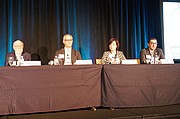RETAIL
Riding Out Big Changes in Retail at Marcum Panel
There are 26 square feet of retail for every man, woman and child in the United States, according to a statistic quoted by Robin Lewis, chief executive and editorial director of The Robin Report, a platform covering retail.
The great abundance of retail mixed with forces such as economic turbulence, a revolution in technology and a change in the way people shop has turned retail upside down in the past decade. Lewis was one of several speakers at the recent Marcum Retail Symposium discussing big changes facing retailers. Lewis and the panelists also talked about what retailers need to do to get in front of a new wave of technological and social change.
Lewis said change is crucial for survival. “We are in a retail tsunami. The $64,000 question is, Are we moving fast enough?” Lewis said about the shifting landscape. “It will wipe out retailers that did not fundamentally transform their business.” He ended his thought with a paraphrase of a famous sentence from Charles Dickens’ novel “A Tale of Two Cities.” “We live in the most exciting times and the most challenging times,” Lewis noted.
Bringing other points of view to the symposium was Debra Gunn Downing, executive director for marketing of the South Coast Plaza, a luxury retail center in Costa Mesa, Calif.; JPMorgan Chase executive Louis Mastrianni, who focuses on the bank’s apparel industry practice; and Andrew Rotondi, chief operating officer of Dynamic Worldwide, which provides logistics services to apparel and consumer businesses. Producing the March 16 event was the California Fashion Association and Marcum LLP, an accounting and advisory firm. More than 200 people attended the event at the JW Marriott hotel in downtown Los Angeles.
At the center of this time of change is the consumer, equipped with a smartphone, who can order goods anytime and anywhere, often confounding retailers’ expectations. “The consumer is the new P.O.S.,” Lewis said, referring to point-of-sales systems, a term that once referred exclusively to cash registers. Now a point of sale can be a tablet or a smartphone or a computer screen. “But Marketing 101 has not changed; you still have to know your consumer down to her DNA,” he said.
Young consumers do not shop like previous generations; many seek products and services infused with a direct connection between the brand and the shopper, Lewis said. “The industry is leaving $250 billion on the table because of lack of personalization,” he said. Personalization can range from training sales staff to act as ambassadors for a brand to using “predictive analytics,” which delve into a science fiction–like field of anticipating what consumers need and want.
Looking into the future, retailers will need to change their physical stores into places where people will consider hanging out. Shoppers also will increasingly seek out independent, neighborhood stores that are equipped with the latest technology. “The future of technology is going to reverse centralization, consolidation and ‘massification,’” Lewis said.
Rotondi, the logistics expert, agreed that creating the right environment was crucial. “If you don’t have the right customer experience and technology, you are not going to be around,” he said.
Downing noted great change had also come to retail advertising. Social-media postings with fashion stars such as Gigi Hadid connected with a greater audience than traditional retail advertisements. Retailers will have to become the best hosts. “From someone from overseas who is looking for someone who speaks his language in a store to a millennial looking for authenticity to an older person looking for personalization, we have to be aware of all constituencies,” she said.
Mastrianni said the market is developing for “pure play” e-commerce retailers, or those e-tailers that do not run physical stores. While many are “pre-profit,” he noted that some of these e-tailers “are figuring out smart ways to bring client acquisition costs down.”
The panelists agreed that success awaited those who could ride out this era’s big changes in retail. “We’re just at the beginning of this,” Lewis said. “It’s chaotic. But if you keep working at it, you will understand it.”






















